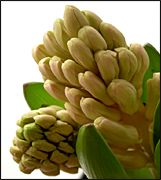People today want convenience, whether it be from their bank, credit card, favorite retail store, or restaurant. They demand it from the companies who hold their loyalty, including their health care providers (you). They don’t want to call and possibly be put on hold, and they want to use an app or schedule an appointment on your website. Here are three reasons your practice can gain by switching to online appointment scheduling.
Herbs & Botanicals
Hyacinth Bean (bai bian dou)
What is hyacinth bean? What is it used for?
Hyacinth bean is not technically a "bean," but rather the seed of the hyacinth plant, a slow, climbing vine that can grow up to 20 feet in length and is often used as an ornamental plant on walls, fences and trellises. The hyacinth consists of thin, rope-like vines, with green and red or magenta-colored foliage.
The seeds are kept inside shiny, magenta-colored pods that sprout along the vine. The seeds are very similar to white beans in appearance (hence the name "hyacinth bean"). They are elliptical in shape, and usually range between 8 and 13 millimeters in length. Externally, they are white in color, with a hard texture and a slight odor. The seeds are usually dried and baked before being used in herbal remedies.
 Hyacinth beans contain a variety of elements and compounds, including vitamins B1 and C; linoleic acid; oleic acid; leucine; carotene; sucrose; glucose; calcium; iron; and zinc. In traditional Chinese medicine, hyacinth beans are associated with the Spleen and Stomach meridians, and have sweet and neutral properties. They are used to strengthen spleen qi (which helps stop diarrhea), and to clear heat and dampness. Stir-baked hyacinth beans are also used to promote appetite, treat a distended abdomen, and reduce the incidence of nausea and vomiting. Some research has shown that hyacinth beans can strengthen the immune system, and inhibit the production of certain bacteria. Hyacinth beans are often used in conjunction with other herbs, such as agastache and magnolia.
Hyacinth beans contain a variety of elements and compounds, including vitamins B1 and C; linoleic acid; oleic acid; leucine; carotene; sucrose; glucose; calcium; iron; and zinc. In traditional Chinese medicine, hyacinth beans are associated with the Spleen and Stomach meridians, and have sweet and neutral properties. They are used to strengthen spleen qi (which helps stop diarrhea), and to clear heat and dampness. Stir-baked hyacinth beans are also used to promote appetite, treat a distended abdomen, and reduce the incidence of nausea and vomiting. Some research has shown that hyacinth beans can strengthen the immune system, and inhibit the production of certain bacteria. Hyacinth beans are often used in conjunction with other herbs, such as agastache and magnolia.
How much hyacinth bean should I take?
The amount of hyacinth bean to be taken depends on the condition being treated and the way it is administered. Orally, the recommended dose of hyacinth bean is 5-10 grams per day, either as a decoction, pill or powder. Some herbalists recommend using concentrated hyacinth extracts at the rate of 1-2 grams per day.
What forms of hyacinth bean are available?
Hyacinth bean is available in a variety of forms, ranging from pills and powders to liquid extracts and decoctions.
What can happen if I take too much hyacinth bean? Are there any interactions I should be aware of? What precautions should I take?
While there is no evidence that large amounts of hyacinth bean are associated with adverse side-effects, some research suggests that the beans can cause abdominal discomfort if they are not cooked properly. They should not be prescribed to patients who are suffering from intermittent chills, colds or flu, or to patients with yin deficiency with blood heat or qi deficiency without stasis. As of this writing, there are no known drug interactions with hyacinth bean. As always, make sure to consult with a licensed health care provider before taking hyacinth bean or any other herbal remedy or dietary supplement.
References
- Chinese Materia Medica. Shanghai Science and Technology Press, 1998.
- Modern TCM Pharmacology. Tianjin Science and Technology Press, 1997.
- Li XF, et al. Analysis of one case of uncooked bian dou. Journal of Shizhen Medicine 1999;10(10):771.
- Zhao LK, et al. Comparison and research on organism defense function effects of various tonic herbs. Shannxi Journal of Traditional Chinese Medicine and Herbs 1990;31(4):52-53.
- Zheng JL. Pharmacology research and clinical application of bian dou. Journal of Shizhen Medicine 1997;8(4):330-331.


